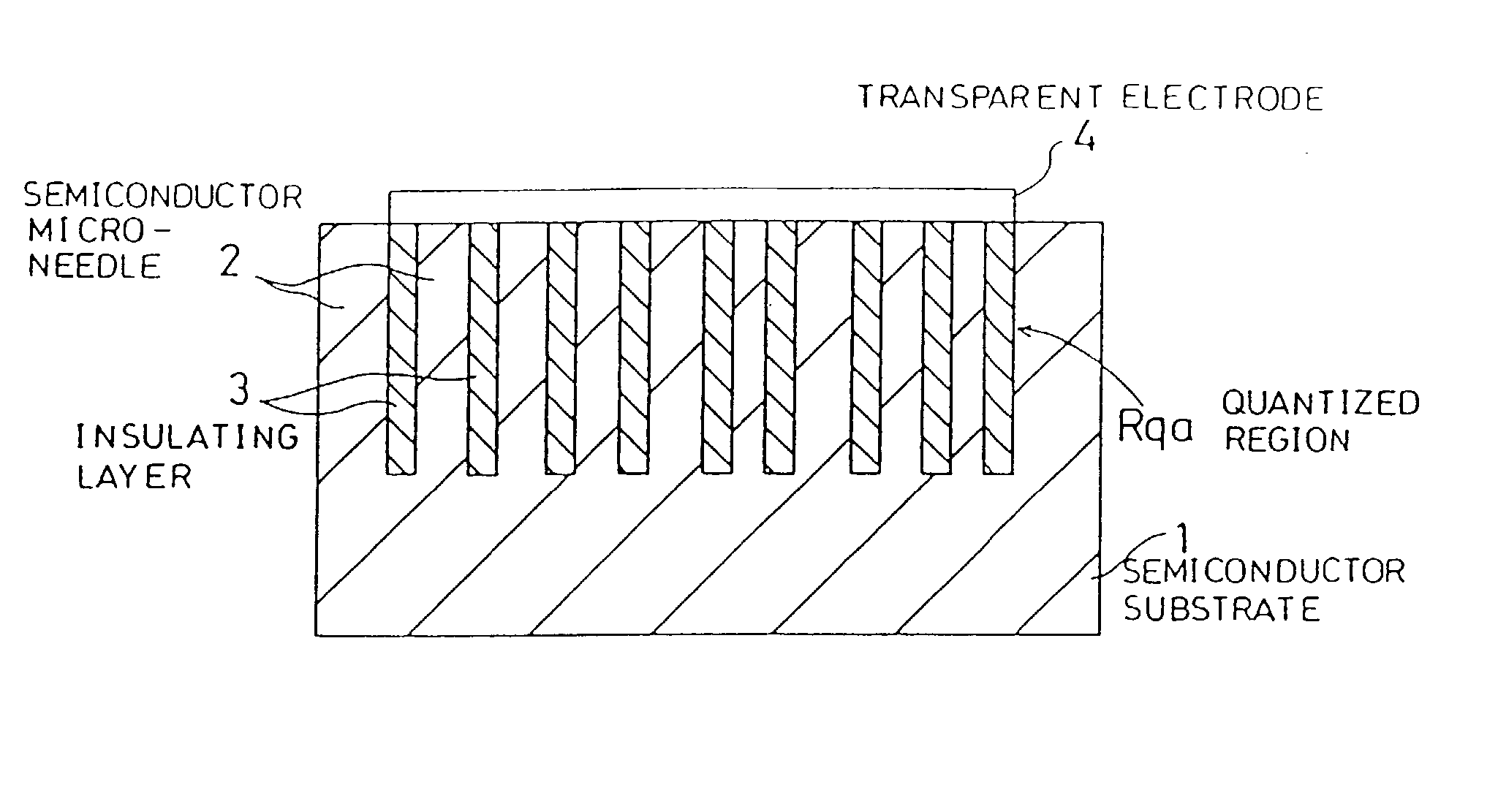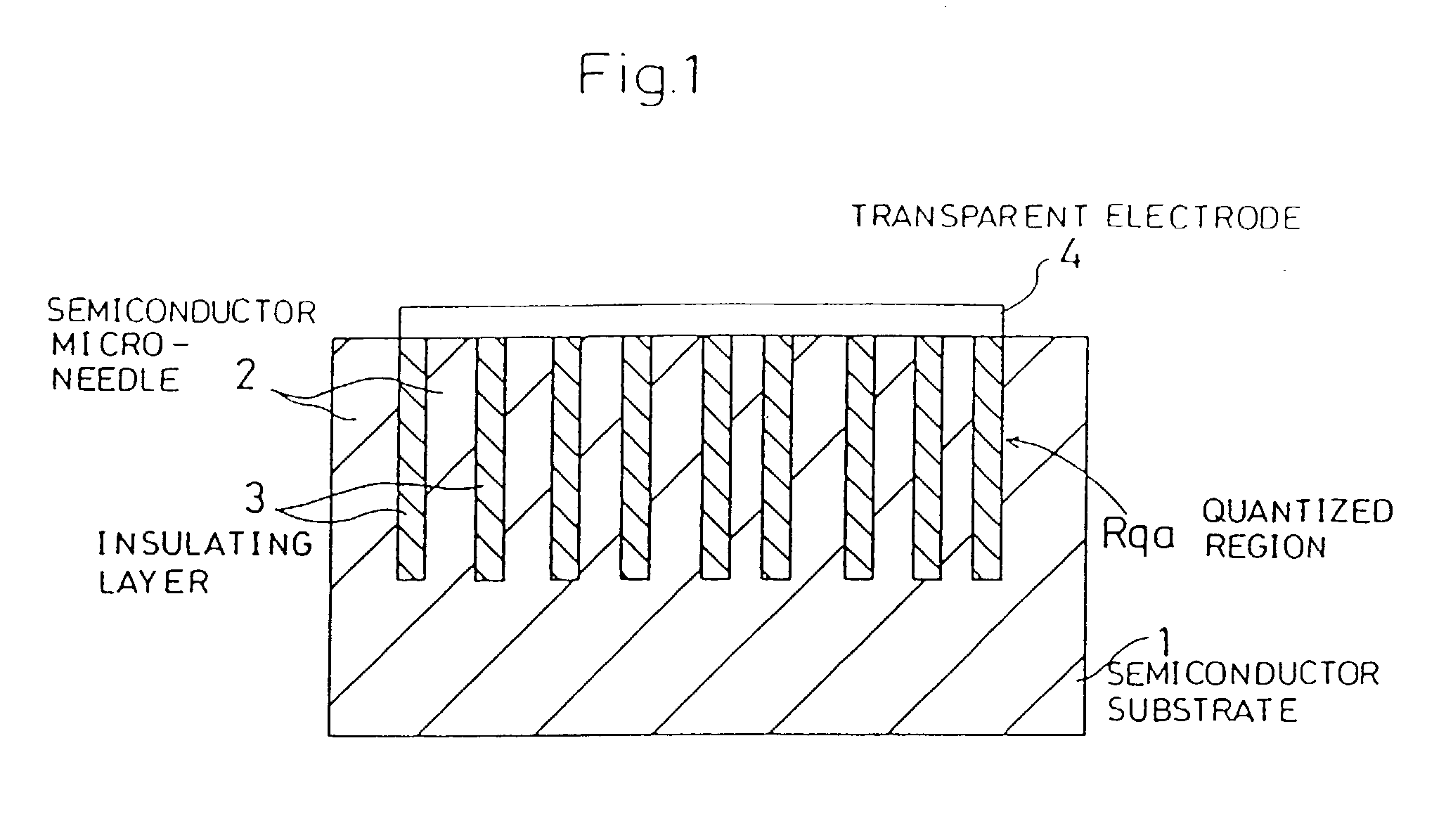Aggregate of Semicnductor micro-needles and method of manufacturing the same, and semiconductor apparatus and method of manufacturing the same
a technology of semi-cnductors and micro-needles, which is applied in the manufacture of final products, sustainable manufacturing/processing, instruments, etc., can solve the problems of difficult control of the diameter and depth of the micro-pore 102 formed by anodization, difficult to achieve the effect of enhancing the quantum size effect and facilitating manufacturing
- Summary
- Abstract
- Description
- Claims
- Application Information
AI Technical Summary
Benefits of technology
Problems solved by technology
Method used
Image
Examples
first embodiment
[0075] (First Embodiment)
[0076] A description will be given first to a first embodiment. FIG. 1 is a cross-sectional view of an optical semiconductor apparatus according to the first embodiment. As shown in the drawing, the semiconductor apparatus comprises: a silicon substrate 1 of single-crystal structure; a large number of semiconductor micro-needles 2 extending from the surface of the silicon substrate 1 to a specified depth so that the axial direction thereof is perpendicular to the surface of the substrate 1; an insulating layer 3 composed of a silicon dioxide film which fills up the space surrounding each semiconductor micro-needle 2; and a transparent electrode 4 formed on the flattened top ends of the semiconductor micro-needles 2 and the insulating layer 3. An aggregate of the foregoing semiconductor micro-needles 2 functions as a quantized region Rqa. Those ends of the above semiconductor micro-needles 2 which are closer to the substrate 1, hereinafter referred to as "bas...
second embodiment
[0107] (Second Embodiment)
[0108] Next, a description will be given to a second embodiment. FIGS. 8(a) to 8(e) illustrate the process of manufacturing the optical semiconductor apparatus according to the second embodiment. The manufacturing process used in the second embodiment is substantially the same as the manufacturing process used in the above first embodiment, except that the conditions under which the hemispherical grains 6 are deposited by LPCVD are changed and that the space surrounding each semiconductor micro-needle 2 is filled up with a silicon dioxide film 3b formed by CVD or the like after the side portions of the semiconductor micro-needles 2 were covered with a thermal oxidation film 3a, followed by the flattening of their surface regions. In other words, these two types of oxide films 3a and 3b constitute an insulating layer 3.
[0109] In the step of depositing the hemispherical grains 6, a He-based 15% SiH.sub.4 gas is used as a raw material so as to deposit the hemi...
third embodiment
[0117] (Third Embodiment)
[0118] Next, a description will be given to a third embodiment for improving the configuration of the hemispherical grain 6. After the hemispherical grains 6 are formed by substantially the same manufacturing process as that of the above first embodiment, the SiH.sub.4 gas in a tube is evacuated, followed by annealing while introducing N.sub.2 gas, which is an inactive gas, into the tube. FIG. 11 shows the relationship between the annealing period and the grain diameter and density. It will be appreciated that the grain diameter decreases with an increase in annealing period. Since the surface and interface tend to shrink with a decrease in grain diameter, the configuration of the grain becomes closer to a hemisphere, resulting in a high increase rate of the surface area of the grain. If the annealing period becomes 2 minutes or longer, the region with no hemispherical grain expands. The increasing difficulty with which the hemispherical grains 6 are formed ...
PUM
 Login to View More
Login to View More Abstract
Description
Claims
Application Information
 Login to View More
Login to View More - R&D
- Intellectual Property
- Life Sciences
- Materials
- Tech Scout
- Unparalleled Data Quality
- Higher Quality Content
- 60% Fewer Hallucinations
Browse by: Latest US Patents, China's latest patents, Technical Efficacy Thesaurus, Application Domain, Technology Topic, Popular Technical Reports.
© 2025 PatSnap. All rights reserved.Legal|Privacy policy|Modern Slavery Act Transparency Statement|Sitemap|About US| Contact US: help@patsnap.com



